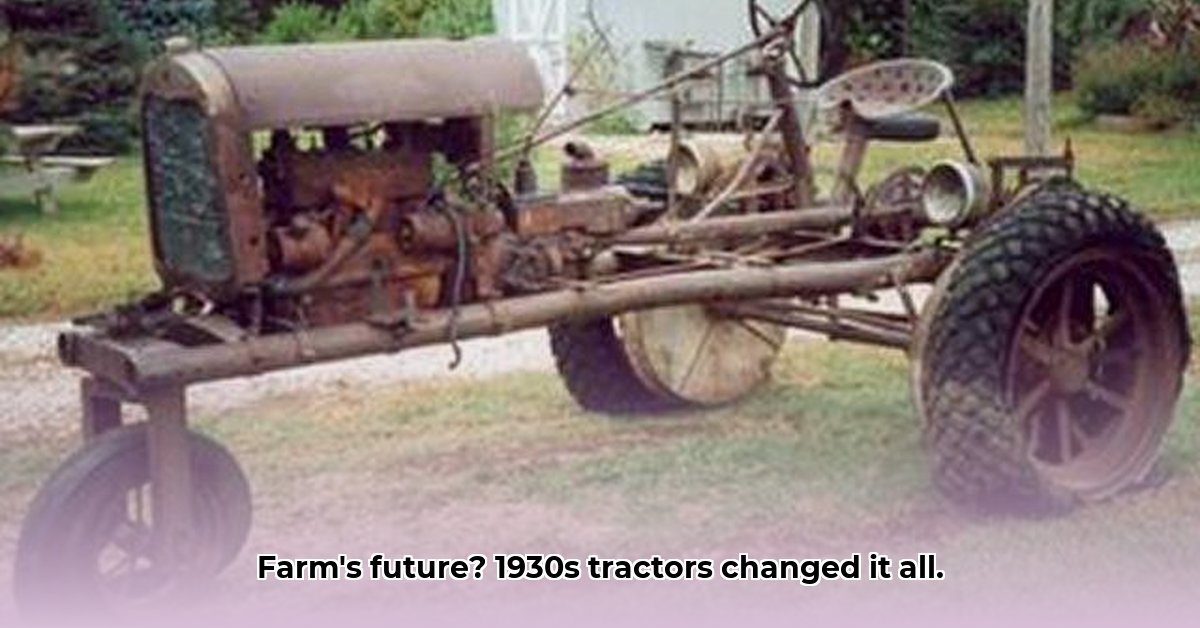
The 1930s, a decade defined by the Great Depression, witnessed a quiet revolution in American agriculture. While economic hardship gripped the nation, the introduction and refinement of the International Harvester Farmall tractor offered a beacon of hope, transforming farming practices and bolstering food production during a time of immense need. This article delves into the technological advancements, historical context, and lasting impact of these iconic machines. For more detailed model specifications, see this 1930s Farmall resource.
A Tough Decade, a Smart Response: The Farmall's Rise
Farmers faced dire circumstances during the Depression: plummeting crop prices and a lack of affordable equipment threatened their livelihoods. International Harvester (IHC), recognizing this crisis, responded with a strategic solution: improving the already popular Farmall tractor line to make it accessible and efficient for a wider range of farmers. This wasn't merely about increasing horsepower; it was about fundamentally re-shaping the relationship between farmer and machine.
IHC's response wasn't a single model but a family of tractors. The introduction of models like the F-12, F-20, F-30, and F-40 offered farmers a choice, mirroring the automotive industry's approach of offering various vehicle sizes to suit different needs. This strategic diversification ensured more farmers could afford and utilize the technology, regardless of the scale of their operations. But how did these tractors change the game?
More Than Just Horsepower: Big Technological Upgrades
The improvements went beyond sheer power. One transformative change was the adoption of pneumatic tires. Replacing the harsh steel wheels of earlier models with pneumatic tires drastically improved comfort, speed, and reduced wear and tear on both the tractor and the land. “The reduction in ground compaction from pneumatic tires alone made a massive difference to farmers,” notes Dr. Amelia Hernandez, Agricultural Historian at the University of Illinois. This seemingly simple change resulted in increased efficiency and productivity.
However, the transition wasn't straightforward. Finding tires that provided both sufficient traction in the fields and a smooth ride on roads required significant research and development. The engineering challenge involved balancing these competing requirements to maximize the benefits of the new technology.
Furthermore, while IHC initially didn't adopt Harry Ferguson's revolutionary three-point hitch system, its efficiency was undeniable. The system's impact on ease of implement attachment undeniably influenced tractor design moving forward.
Changing Lives: The Impact of 1930s Tractors
The impact of these advancements was profound. Farmers could cultivate more land in less time, leading to increased crop yields. This boosted not only individual farm income but also played a critical role in maintaining national food security during the Depression. The increased food production of this era almost certainly averted a far greater humanitarian crisis. "These tractors were essential to the American food supply during a period of extreme economic hardship," states Professor David Miller, Agricultural Engineering Department, Purdue University.
Was it simply a technological boon, or more? The 1930s Farmall tractor acted as more than just equipment; it represented a lifeline, providing farmers with the tools to weather the storm and maintain their operations.
Looking Back: Lessons Learned
The success of 1930s tractors distills into several key lessons. Firstly, it demonstrates the importance of adapting to economic fluctuations. IHC's strategic diversification is a testament to the necessity of responding to market demands successfully. Secondly, the cumulative effect of seemingly small improvements (pneumatic tires, engine enhancements) underscores the power of incremental innovation. Finally, it emphasizes the importance of close observation of technological advancements from competitors, even if not immediately adopting them.
How to Compare 1930s Farmall Tractor Models Based on Fuel Efficiency
Determining the fuel efficiency of 1930s Farmall tractors requires a different approach than with modern machines. Precise data is scarce, but comparative analysis is achievable by employing indirect methods. This is not just about raw numbers but understanding the nuances of technology and context.
Understanding the Challenge: Fuel Efficiency in the 1930s
Direct fuel consumption figures were not consistently recorded or standardized in the 1930s. To compare different models, consider the following factors:
- Engine Type: Gasoline engines were prevalent in early models, while later models introduced diesel engines, typically offering better fuel economy.
- Engine Size: Larger engines generally consumed more fuel but provided greater power.
- Operational Conditions: Terrain, soil type, and the implements used significantly impacted fuel consumption.
- Maintenance & Operator Skill: Proper maintenance and skilled operation improved efficiency.
Indirect Methods for Comparison
To navigate the lack of direct data, use indirect methods:
- Original Manuals: While idealized, manuals furnish some fuel consumption estimates.
- Period Publications: Agricultural magazines from the era provide valuable comparative reviews and owner testimonies.
- Engine Design: Analyze engine specifications to indirectly compare potential fuel consumption.
- Implement Use: Consider the energy demands of different farming tasks.
- Expert Consultation: Engage with Farmall enthusiasts and restoration experts to gather anecdotal evidence.
By combining these methods, a relative assessment of fuel efficiency among the various 1930s Farmall models becomes achievable. The focus shifts from a precise numerical comparison to a contextual understanding of their performance in the agricultural landscape of the Depression Era.